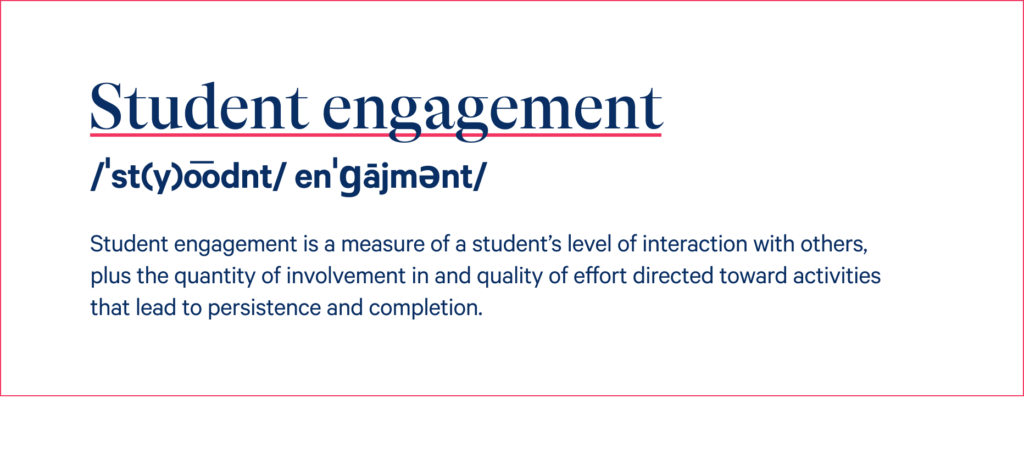Student engagement is a critical measure of long-term student success — but the exact definition of student engagement has been notoriously difficult to pin down. When you think about student engagement, you may picture a student actively participating in class, leading study groups, or attending extracurricular activities and events. But that only scratches the surface.
A lack of clarity around what student engagement really means can cause institutions to invest time and money on strategies and tools that don’t align with their student success objectives. To make meaningful improvements, we have to identify the types of engagement that drive student success.
Thankfully, today’s emerging technologies make it possible to measure and improve student engagement in ways that were impossible in the past.
What is student engagement?
In our new white paper, “Defining student engagement,” we explore the various ways experts have defined student engagement over the past 40 years. We also look at how those definitions have evolved over time. And we examine which key elements form the building blocks of meaningful student engagement today.
Based on these inputs, the white paper proposes a definition of student engagement. Our definition does not intend to prescribe a universal meaning for the term. Rather, we hope it will start a conversation that can help administrators and higher education decision-makers consider what student engagement means to them today.
Definition: Student engagement is a measure of a student’s level of interaction with others, plus the quantity of involvement in and quality of effort directed toward activities that lead to persistence and completion.

The “activities” mentioned in this definition might include actions that are essential for continued enrollment — like completing the FAFSA on-time or resolving a registration hold. In order to achieve successful outcomes, a student needs to not only perform basic tasks, but also connect in deeper ways with their coursework and their faculty, advisors, and peers.
How student engagement impacts long-term success
The goal for most institutions isn’t just to get students more engaged — it’s to equip students with the skills they need to succeed in the real world. With this objective in mind, student engagement may be as important to success as academic outcomes are.
Still, many colleges measure student outcomes with specific data related to enrollment, retention, and graduation. There are a number of factors to consider beyond the academic experience, though.
For example, the most engaged students demonstrate both an intellectual and an emotional connection to their school. That’s a balance that will serve them well after graduation, and especially as they embark on their career paths. Learning how to be an engaged student is an important skill that promotes empathy and collaboration with peers. It also prepares students to process criticism and feedback from mentors.
Building student engagement during a crisis
Since the onset of the COVID-19 pandemic, there’s been a renewed need to focus on student engagement. As students shifted to remote and hybrid learning models, colleges had to find new ways to keep students engaged when they were off-campus. Building connections through intentional outreach can help create a sense of belonging for students. Doing so can bring them closer to the campus experience — even in a remote environment.
This is where balancing the quality and quantity of engagement activities comes into play. When you can’t rely on daily, in-person interactions, you need to find ways to make every interaction relevant and meaningful for the student. Colleges and universities are tasked with finding new ways to connect with students on their terms.
The student engagement metrics that matter most
Every college and university defines student engagement slightly differently. And these benchmarks often evolve over time. At its core, though, there are four key factors you should consider when defining what meaningful engagement looks like at your institution:
Involvement
Part of how you can measure student engagement is by observing how students spend their time. Specifically, how their time is devoted to activities that will help them succeed both in and out of the classroom.
Quality of effort
The depth of student engagement is another key component. Time spent in a classroom or participating in activities is not nearly as meaningful unless the student is invested and engaged throughout the process.
Interaction
Students are more likely to succeed when they have a strong support system in place. This is why peers, instructors, counselors, and coaches are essential to student success. Emerging research suggests that when that support is delivered through technology, it can be just as effective as in-person engagement. Behaviorally intelligent chatbots that provide the right level of personalized, conversational engagement 24/7 can effectively expand the support network an institution offers its students.
Intentionality
Student engagement factors into both intentional and organic interactions. When institutions focus on intelligent design — like including more communal spaces in residence halls — they can help cultivate a more natural environment for spontaneous engagement.
How a sense of belonging relates to student engagement
Interactions that directly support students’ mental health are top of mind for most colleges and universities today. Since a student’s sense of belonging on campus directly affects their feelings of acceptance, respect, value, and happiness, this type of engagement is also a key predictor of student success.
When colleges or universities evaluate levels of engagement, they should also analyze how engagement differs along lines of race, finances, and other demographic factors. It’s important to examine the ways that conventional measures of engagement may not consider a student’s background, socioeconomic status, or identity. These questions are critical as institutions strive to support students from all backgrounds.
While engagement and belonging are not synonyms, they are inextricably linked when it comes to the higher education experience. That’s why exploring ways to develop a sense of belonging for all students needs to be considered an essential piece of the student engagement puzzle.
Join the student engagement conversation
Download Mainstay’s white paper, “Defining student engagement” to explore the history of student engagement — and discover ways you can establish, measure, and improve student engagement at your institution.


